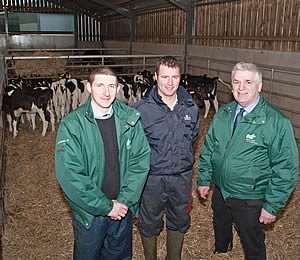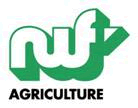 |
|||||||||
|
|||||||||||||||||||
|
|
NWF Broathill Farm Youngstock Open Day With the average dairy cow taking 1.3 lactations to recover her rearing costs, understanding the investment to calving and paying close attention to detail is vital to improve whole herd profitability.
Effective youngstock management was the focus of an on-farm meeting at Broathill Farm, Kirkpatrick Fleming, Lockerbie on Wednesday (Dec 7) organised by NWF Agriculture in association with vet group, Solway Vets and animal nutrition specialists Provimi and Frank Wright Trouw. NWF has developed a new approach to managing cows called Profit for Life, which considers factors including culling rate, fertility and transition management, yield - and age at first calving. “It is essential to understand the costs of the rearing investment which is directly affected by age at first calving,” NWF’s Tom Hough told producers at the open day. “Key to this is when an animal first breaks even - when income to the farm matches the rearing cost and she starts adding to the bottom line - and on average this is around 1.3 lactations. “The longer she is in the herd for the better to maximise lifetime contribution, however the average UK cow only completes just over 3.5 lactations - so she is only profitable for 2.3 lactations,” he added. At Broathill Billy Halliday and his parents Thomas and Christine have been making significant investment in their pedigree Holstein dairy herd in recent years, building new calf housing with automatic calf feeders and a 220 cow cubicle shed to increase numbers to 280 cows and allow year-round housing. The herd averages 10,800 litres at 4.1 per cent butter fat and 3.24 per cent protein. Thirty five per cent of the herd are heifers in milk and the focus is on reducing the age at first calving from 2.4 years to 2 years to achieve profitability quicker. The heifer rearing policy is to get calves on to dry feed as quickly and healthily as possible with as little stress to the heifer calf to ensure daily liveweight gains to achieve target bulling and calving weights. Vet Iain Dick, of Andrew Miller and Partners, Lockerbie, a member of Solway Vets, explained the importance of ensuring calves received four litres of good quality, dense, colostrum - equivalent to 10 per cent of their bodyweight - within the first six hours of life. He said a strategy against disease should be discussed with the farm vet depending on whether there were problems with pneumonia, coccidiosis or worms. “Lungworm is becoming a bigger issue because of wet summers and mild autumns when cows are kept outside longer and have a few weeks’ increased challenge. Vaccination pre-turnout with Huskvac is a good policy,” he said. Cows should be tested for Johnes antibodies at drying off and if positive the calf should be given colostrum from a cow which has tested negative to prevent its spread. All calves should be taken off their dams as soon as possible. Looking at heifer nutrition from birth to three months of age, NWF’s James Slater and Provimi’s Norman Downey. James Slater said of the four million dairy calves born in the UK each year, six per cent die before they reach six months of age, however, significantly greater financial losses were caused by debilitating diseases which do not kill the animal but affect performance in the lactating cow. Fourteen per cent of heifer calves do not make their first lactation while a furgther 15 per cent do not make their second lactation. To ensure calves got off to a good start and received antibodies through colostrum, their weight gain should be assessed at two weeks and six weeks old. By about 60 days they should be weaned when they are eating approximately 1kg a head a day of early weaning concentrate for three consecutive days. Weaning should not be before five weeks as calves tend to be less resistant to disease. “It’s so crucial that they get that first feed of colostrum then followed by good quality milk powder which is expensive but necessary and aim for intakes of around 800g a day of milk powder (dry matter). Cleanliness is also critical,” he added. Norman Downey said it was important to help the rumen develop by promoting dry matter intake to 80 per cent of its capacity by 12 weeks old. Butyric acid in starch and sugars was the key to encouraging papilla growth in the rumen. Essential oils in the feed helped to encourage intakes and fight non-desirable bugs such as e-coli and salmonella while probiotics helped to promote the good bacteria. John Twigge, technical and marketing manager with Frank Wright Trouw Nutrition, said the cost of rearing a heifer was £1,300 and the target was to inseminate heifers at 13-14 months old at a weight of 400kg to calve at 600kg to ensure animals generated more profit. “To me, it’s common sense and I hope producers can give heifer rearing as much attention as they have given to lactating cows in the last few years which has made the UK as good as anywhere in the world in applying the principles of dairy farming. “If heifers are calved later it has severe financial consequences for the business. Calving at 30 months old rather than at 24 months means you have to have 25 per cent more heifers - that’s 25 per cent more mouths to feed, just one area where the money starts to drain away from the business,” he added. The critical period of growth (Hyperplasic growth) was from four to 12 months of age when damage the mammary cells increase in size. During the first 4-5 months, mammary cells increase in size while between 5-11.5 months mammary cells increase in number. “Those who house heifers all the time do not find it difficult to control but the big problem is when they are out at grass - you don’t know how much they are eating or the nutritional value - and it’s then when you lose control and the heifers become little butterballs. “Keep on top of growth rates by controlling stocking rates, either by using an electric fence or smaller paddocks,” he said, emphasising that the target should be a daily liveweight gain of 0.8kg. Weight for age: 3 months = 115 kg Total gain = 490 kg
|
||||||||||||||||||

|
|
||||||||||||||||||
| home | agri-services | pedigree
pen | news | dairy | beef | machinery quota | property | organisations | site map |
|||||||||||||||||||

